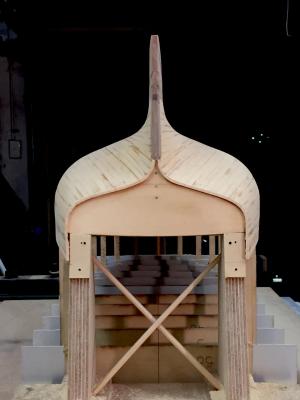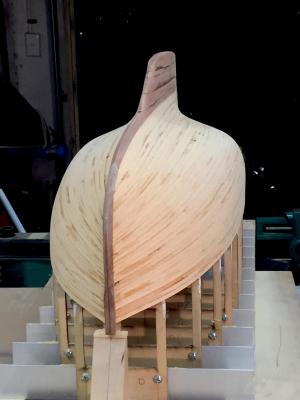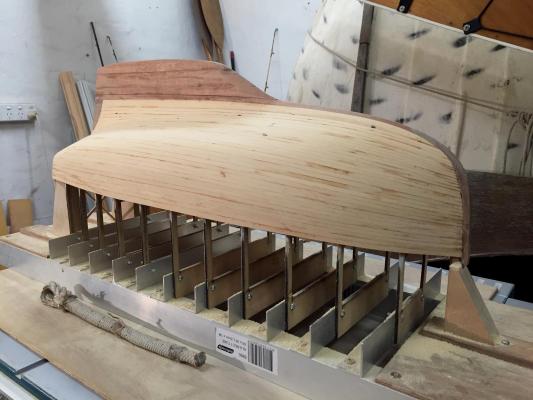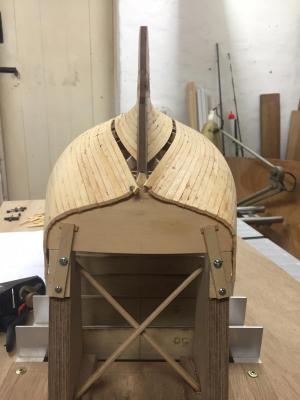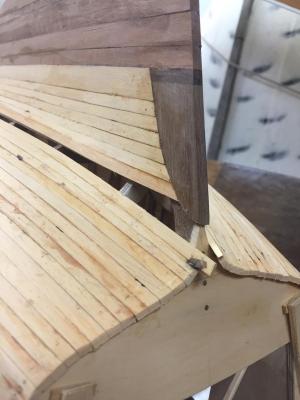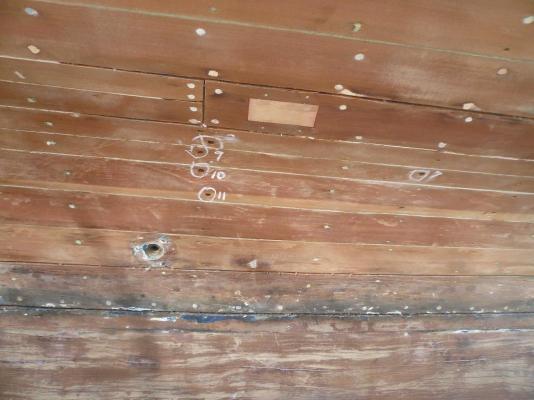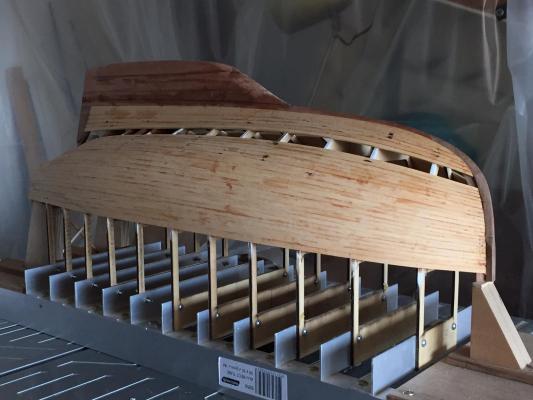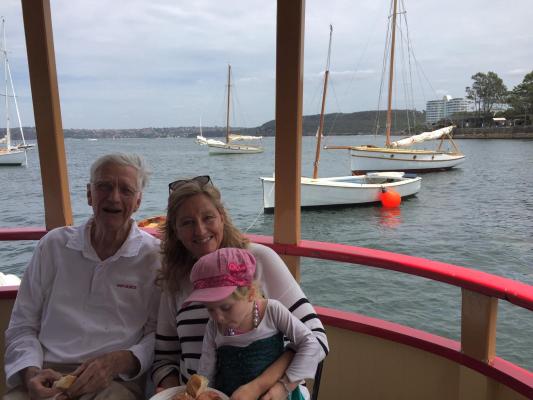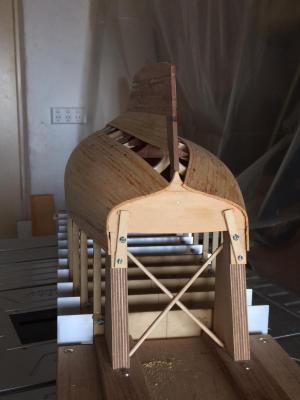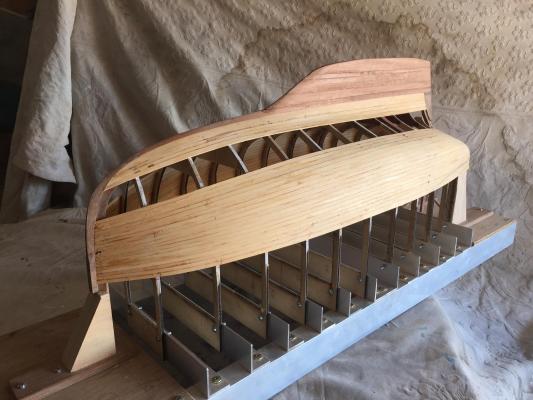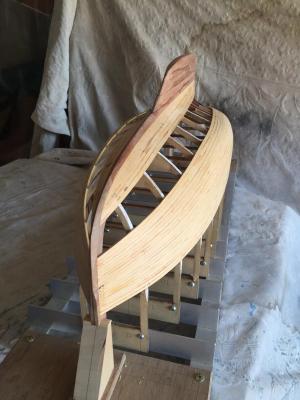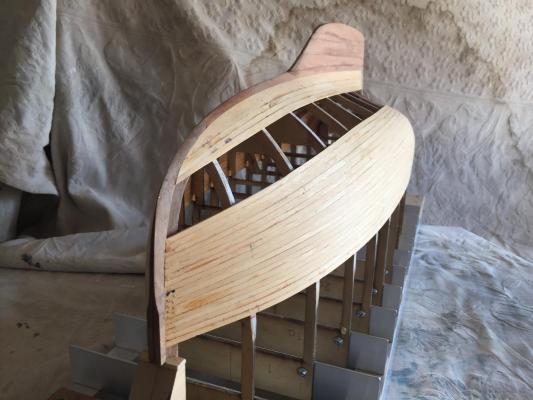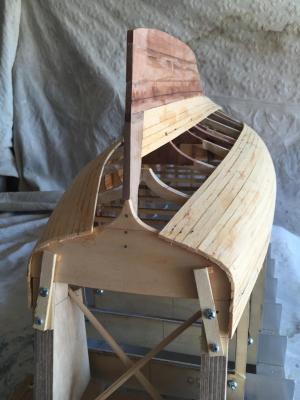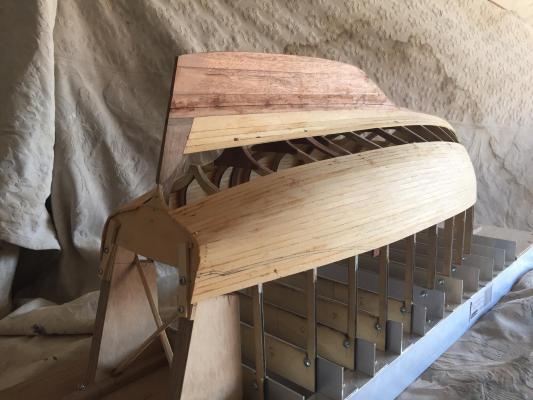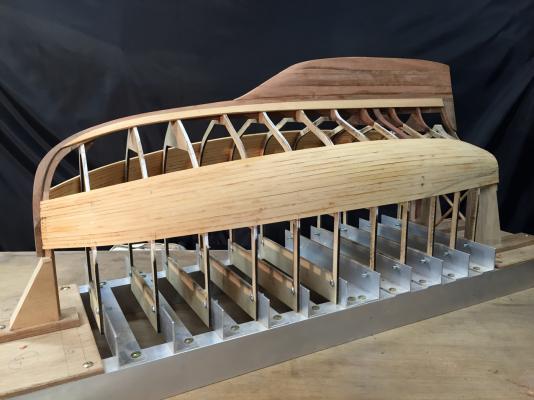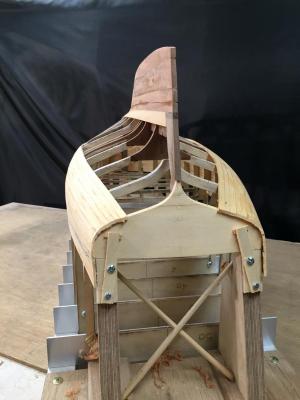-
Posts
820 -
Joined
-
Last visited
Content Type
Profiles
Forums
Gallery
Events
Everything posted by Mark Pearse
-
Michael, interesting thoughts - and I did get the idea for this building frame from your skipjack frame. The high moulds did allow manual access, but they did need to be braced a bit as the thin ply was quite flexible. It could be braced in a more thoughtful way than I did it, perhaps tensile bracing... On the planks, they are to scale & tapered based on the set out I did for the hull, & I didn't need to spile them in the way I read about in the planking primers - I think because the Huon Pine is so supple it allowed me to get the wood to the shape of the last plank. When a little twist or lateral bend was needed, I - like I see you did - used a heat gun & clamped the other end of the plank to a bench. There are a few wobbles if you look along the planks, & when painted I think that you will see some evidence of the lines of the planks through the paint, but you won't see enough to pick up the wobbles. A long rambling way to say that the stealers were based on the stealers in the full sized 24 footers. I'd like to do a model with an interior, there's a lot of pleasure in seeing a traditional boat hull interior - to model scale or full scale.
-
thanks guys, Bedford, I especially like the transom shape, at this stage it still looks similar to Ranger's (first blog entry has photos), but I think that when the transom fashion piece goes on, the planking ends are fined off & the hull sides are shaped to suit the raised deck etc, it will be the prettiest transom in a pretty good looking bunch. Mark
-
thanks all Planking completed & some rough sanding done. There are some planks where it may be easier to infill thin strips of timber on top of the planks than to sand it all back to the lowest part. You can see in one of the photos that this is the case for the upper edge of the port side garboard plank, the change in colour of the sanding highlights the recess. I think it would be pretty easy to thin down some timber & glue it on. Yes, Michael, I'm wondering about the next few stages...there's always the attraction of doing next the stage that will give the most dramatic visual change, over a more reasoned & sober reckoning. So, after sanding the hull, & probably undercoating & marking the waterline while the base it there holding the hull level, I will no doubt succumb to the most dramatic visual change & do the deck & the basic parts of the cockpit area. The model is still a bit scaleless with no parts to give the eye a reference of size, & I'm keen to get a sense of the yacht's design & feel.
-
Pretty boat, pretty model; hard to believe they are only 14 foot long, a big little boat indeed. Do they ever carry spinnakers?
- 258 replies
-
- buzzards bay
- herreshoff
-
(and 1 more)
Tagged with:
-
One plank remains & it's the one with a stealer, but when I checked through some photos, it's actually not going to be as difficult as I was expecting. In one of the excellent forum primers on planking, it describes how to do a stealer plank on a ship. But I'm going to do it as in the photo below, from our boat Cherub - you can see where one plank stops & becomes two that take up the extra width further down. So I guess that's how they did it for this scale of boat in Sydney at that time. It will make it a lot simpler too.
-
I'm still here, still working slowly away when I can. Planking is closer, 4 planks left each side plus a stealer .... & I'm still hoping that the clouds will part soon & reveal whereth should reside the stealer plank... But there's still time for that so I'll press on at my glacial pace & hope that it will all become clear at the appropriate time. Today we celebrated the 90th birthday of Bill Gale (son of the designer of the craft I'm building). Retired from sailing last year after 75 seasons; Bill with two lady admirers, Ranger (the boat that started it all) & our boat Cherub (further away).
-
nice; but who did those beautiful watercolours on the wall? I love the boat, but they are really great paintings...
- 2,207 replies
-
When you see the mast, it's amazing to see how small the keel area is in relation to it, I suppose it's possible because their likely minimum speed is quite fast compared to a traditional yacht - or do they have dagger boards?
-
thanks, that's clear; & those ropes are beautiful MP
- 253 replies
-
- ketkch
- gaff-rigged
-
(and 1 more)
Tagged with:
-
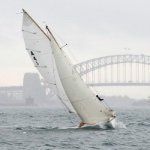
finish
Mark Pearse replied to Barbara's topic in Painting, finishing and weathering products and techniques
Hi Barbara did you see this recent discussion? http://modelshipworld.com/index.php/topic/12198-what-is-a-good-finish-for-stained-planking-edited-by-admin/ best wishes, Mark -
" Should a matt finish be appropriate for this kind of a model that accentuates the texture of woods while keeping the finish from dominating the overall appearance of the model ?" I'm new to this craft so I don't have much experience, but this is similar to a question that I've been chewing over. It seems to me that even the glossiest (full size) boat appears less glossy at a distance, it still looks great but the size & amount of reflections reduces the further away you get. So, my thinking is that a lower level of gloss will look in scale, even if you're replicating a boat that is high gloss. My eye tells me that when a model is done full gloss it looks a bit more like a model than a scaled down version of the real thing (trying not to tie myself in verbal knots....). That isn't to say that either is better, it's just the effect is different. My 2c..... Mark
-
golly, 1600 grit - I did't know it even existed Jay, can you use that for concave curved surfaces? I recently completed a table & was surprised by how when hand planing the tops down to 20mm thick, I was able to feel subtle thickness differences & work out where to remove next. However for some reason I'm unsure of this for a complex curved surface, but perhaps that is inexperience. thanks
-
Hi Vaddoc very nice, she looks absolutely lovely. One small technical point, but my option only - I see that you have reduced the tackle on the forestay, giving a smaller ratio. I think that this is probably more likely than the earlier photo that seemed to have 4:1 ratio or so. With this sort of rig you take up the slack in the forestay & not tighten it a lot, the forestay tensioning is done by the mainsail pulling back against the forestay. You shouldn't tension the forestay because the load pulling aft from the mainsail would vary a lot depending on the angle of sailing, even in a constant breeze. Mark
- 253 replies
-
- ketkch
- gaff-rigged
-
(and 1 more)
Tagged with:
-
Hi everyone, I'm wondering what techniques others use to sand completed planking, where the basic planking lines are good but there is a certain amount of fairing to get down to a faired shape. The planks I've used are around 2.5mm thick, & most will be at least 2mm finished after final sanding with a few parts slightly under that, at maybe 1.75mm. I was thinking of gluing sandpaper on to some flexible strips - maybe 1mm styrene or thin flexible ply - & sanding at various angles. The strips sized for one hand or two hands ..... so that I remove outstanding timber & not sand down where it's not needed. Forum title searches unfortunately didn't really find anything that matched what I'm looking for. ideas ? thanks, MP
-
Hi Jim on reflection, it seems logical to me that it is a toilet: as a pearler they might have had something more basic for the crew, but it's hard to imagine them being able to take paying female passengers without having something discrete. Definitely close enough to the sea for a bucket & chuck it... So a simple way to fit a toilet is just to put one on deck in a convenient location. And looking at the rig setup, it's probably the only spot left. On the screens, an interesting comparison might be a common detail in some tropical Queensland houses: there are plenty of insects but the living areas use a "blow in blow out" insect technique, louvre windows without screens all around & the bugs blow right through, they seemed to value ventilation more highly than a mossie-free room. MP
- 745 replies
-
- francis pritt
- mission ship
-
(and 1 more)
Tagged with:
-
The planking getting close to where stealer planks are needed, I'll probably do one more each side up from the garboard & maybe 3 or 4 more each side down from the gunwales. The planking is ok, a few wobbles, I'm just not sure to what extent that can be sanded out or not - or whether they will be noticeable. If there is any that bother me enough I can cut some softwood veneer strips & glue them on top & fair it. I'll need to read forum threads on sanding, whether to use something more than just fingers. At 28" I am thinking of a small torture board ... there are sanding blocks where are a foam core, or I could glue sandpaper to something flexible. thanks for watching, bye for now MP
-
Pete looking very nice. I am currently doing planks that have quite a lot of twist in them, & seeing your work I was wondering if you put any curve into them before laying them up on the model, or do you just force them into shape? They look like they have at least a 45 twist plus the curve, so it's a good comparison. Thanks - I'm not really sure what others do, so it will help if I find out what others (that have more experience) do. thanks
- 258 replies
-
- buzzards bay
- herreshoff
-
(and 1 more)
Tagged with:
-
Hello Bob I look forward to watching this. Was one of the lines drawings you found by the American shipwright & designer Pete Culler? A friend has done a bit of research on Slocum & believes that Culler's was the closest. Interestingly, this friend also thinks that the design wasn't really a great choice for what he did, being such a shallow shape with no external ballast. But as we know from the text, as a boat she sailed herself very well. Do you have any reflections on this?
-
Hi Pete she is looking lovely, they are sort of a big little yacht - but unfortunately I've never seen one in the flesh. What timber are you using for the building frame? thanks, MP
- 258 replies
-
- buzzards bay
- herreshoff
-
(and 1 more)
Tagged with:
-
thanks guys Yes I find the shape interesting too. As far as I can see, not so many countries really developed beamy boats. There will be a lot of examples that I'm not aware of, but when I think of beamy boats it's American & Australian boat types that come to mind in particular. This design isn't massively beamy at 28' x 9'6", but it's no gazelle either. I like the way this hull shape has a clean water exit aft, but still maintains a lot of bouyancy stability right through to the transom - using the beam to get righting moment rather than by adding more & more lead to the keel. They can be comparatively lightly built & ballasted as a result.
-
The keel was glued up, roughly shaped & glued on. I'm leaving final shaping for later, but it's getting fairly close. The transition at the front edge at the keelson needs to be done carefully & I don't want to rush that. It's quite difficult to get it straight & symmetrical as well. thanks
About us
Modelshipworld - Advancing Ship Modeling through Research
SSL Secured
Your security is important for us so this Website is SSL-Secured
NRG Mailing Address
Nautical Research Guild
237 South Lincoln Street
Westmont IL, 60559-1917
Model Ship World ® and the MSW logo are Registered Trademarks, and belong to the Nautical Research Guild (United States Patent and Trademark Office: No. 6,929,264 & No. 6,929,274, registered Dec. 20, 2022)
Helpful Links
About the NRG
If you enjoy building ship models that are historically accurate as well as beautiful, then The Nautical Research Guild (NRG) is just right for you.
The Guild is a non-profit educational organization whose mission is to “Advance Ship Modeling Through Research”. We provide support to our members in their efforts to raise the quality of their model ships.
The Nautical Research Guild has published our world-renowned quarterly magazine, The Nautical Research Journal, since 1955. The pages of the Journal are full of articles by accomplished ship modelers who show you how they create those exquisite details on their models, and by maritime historians who show you the correct details to build. The Journal is available in both print and digital editions. Go to the NRG web site (www.thenrg.org) to download a complimentary digital copy of the Journal. The NRG also publishes plan sets, books and compilations of back issues of the Journal and the former Ships in Scale and Model Ship Builder magazines.



